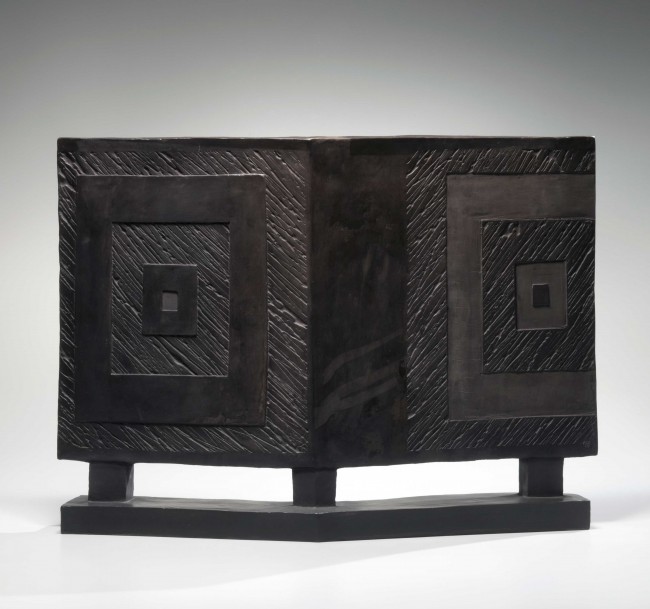
Suit of Armor
Edo period (1615–1868), late 18th or early 19th century
Iron, doeskin, and lacquer
Museum Purchase, 1892.2783
I think the best way – physically and intellectually — to approach the “Modern Voices in Japanese Ceramics and Prints” exhibition at the Cincinnati Art Museum is through the Schiff Gallery and Ambulatory, just up the stairs in the lobby. “Masterpieces of Japanese Art” is installed there, and it lives up to its title. The 100 works from the Museum’s collection span the 12th to the 20th centuries, and all mediums are represented. Some of the most spectacular pieces are an Edo Period (1615-1868) suit of armor; the charming Edo Period Animal Story Scroll by Ogawa Haritsu (1663-1747); intricately carved ivory netsuke from the Meiji Period (1868-1913). I could go on. . . . and on. . . .132

Ogawa Haritsu (1663–1747) 小川破笠
Animal Story Scroll
Edo period (1615–1868)
Handscroll, ink, color, and gold on paper
Gift of the Robert F. Blum Estate
1906.4
Japan’s remarkable ceramic tradition is well represented. There are humble teacups and sake bottles in the wabi-sabi tradition, an aesthetic positing beauty is “imperfect, impermanent, and incomplete.”1 A Meiji Period Teapot looks crude, the potter’s finger marks telling the story of its forming. And then there’s an exquisite and sophisticated vase by a sixth-generation Kinkozan potter, Sobei (1823-1884). On a cerulean ground, Sobei has masterfully painted multi-patterned panels that coordinate rather than clash, a knack the Japanese have mastered. 211

Tower Blue, 1957, Sato Hiromu (b. 1923), color woodcut, Cincinnati Art Museum, The Howard and Caroline Porter Collection, 1990.921
Japan also has a rich printmaking tradition. The West is most familiar with the woodblock ukiyo-e or floating world prints and paintings of the 17th to 19th centuries. They were brought to the West in the mid-1800s, sparking the Japonism trend of the 1870s and influencing Impressionists (Degas, Manet, and Monet), Post-impressionists (van Gogh), and Art Nouveau artists (Toulouse-Lautrec).
The Meiji Period woodcut of an emaciated Female Ghost isn’t what usually comes to mind when Japanese woodcuts are mentioned. The ukiyo-e prints are more colorful, and the subjects far lighter – beauties, kabuki actors, landscapes, erotica, etc. This pale wraith has the starkness and haunting quality found in German expressionist Ernst Ludwig Kirchner’s (1880 –1938) work. 318

Work H-27, 1986, Ando Nana (b. 1948), color photo screen print, Cincinnati Art Museum, The Howard and Caroline Porter Collection, 1990.217
Walking through this gallery gives you concise overview of Japanese art and sets you up to look at the 20th-century ceramics from the Carol and Jeffrey Horvitz collection and prints from the Museum’s collection in “Modern Voices.” The introductory wall text explains, “Following World War II, the arts of Japan experienced a rebirth. Artists worked to integrate Western ideas with Japanese traditions, creating a unique blend of East and West.” 398

Kokutō tōban (Smoke-blackened Ceramic Flat Form), ca. 1991, Yamada Hikaru (1923–2001) stoneware with inlays, smoke blackened, Courtesy of Carol and Jeffery Horvitz
The curators, Amy Miller Dehan, curator of decorative arts and design, and Kristin Spangenberg, curator of prints, believe that the West brought the possibility of sculpture to mediums, such as clay, once used solely for utilitarian purposes. I prefer the ceramic works here that retain that possibility, for example, the tea bowls by Wada Morihiro (1944-2008) and Ajiki Hiro (b. 1948).
Moving to more sculptural forms, my favorite is Suzuki Osamu’s (1926-2000) Kōjin (Foreigner) from 1988. Two glazed stoneware slabs – taller than wide — suggesting a human form despite the abstraction. There are “side seams” where they are joined; the artist has left a vestigial opening at the top corner, a nod to the functional and maybe why I like it.
The curators also say that the Occident brought abstraction to Japan. Judging from the abstract prints on view, Japanese artists embraced abstraction and rejected their own cultural heritage. Only Ikegami Isao’s 1988 Karin [Circle of Fire] color screenprint pays homage to the Eastern aesthetic. A stylized breaking wave – a favorite with ukiyo-e artists — could have been made by a painter’s brush loaded with ink. A tire-like shape encircles it and is speckled as if made by a flicking of an ink-laden brush. It’s the most successful blending of East and West of all the prints on view. 618
The pieces are paired, paired because they carry on dialogues facilitated by their placement in the installation. Yamada Hikaru’s (1923-20001) Kokutō tōban (Smoke-blackened ceramic flat form), c. 1991, consists of two stoneware slabs, joined at an angle to look like the covers of an open book. He’s scored them diagonally and then inset two plain squared “racetracks.” Its geometry starts a conversation with the Sato Hiromu (b. 1923) color woodcut Sakae no. 5 (Posterity no. 5) with its columns and twisting squares in black and a conté-crayon red. Both pieces leave an impression of the emotional darkness of a troubled soul.
The surface decoration on the salt-glazed tea bowl Enyû wan “hotaru” [Firefly], 2010, by Aijiki has a slash of red, disappearing into a charcoal area. That same red shows up as an accent in Ikegami Isao’s (1938) two 1986 color screenprints: Ryu Tai 2 and 3 (Flowering Forms 2 and 3). A zip of red zooms through a black field, a starless night in number 2. In 3 jagged red shapes encroach on a mountain-like silhouette. 796
“Modern Voices” makes a nice counterpoint to the “Masterpieces,” bringing us up to date. I wonder which of these more recent works might make the cut for another edition of “Masterpieces” 100 years hence. 831
–Karen S. Chambers
FOOTNOTES
1 Koren, Leonard. Wabi-Sabi for Artists, Designers, Poets and Philosophers. 1994. Stone Bridge Press.
“Modern Voices in Japanese Ceramics and Prints” through April 26, 2015. Cincinnati Art Museum, 953 Eden Park Drive, Cincinnati, OH 45202. Tues.-Sun., 11 a.m. to 5 p.m. (513) 639-2995, www.cincinnatiartmuseum.org.



